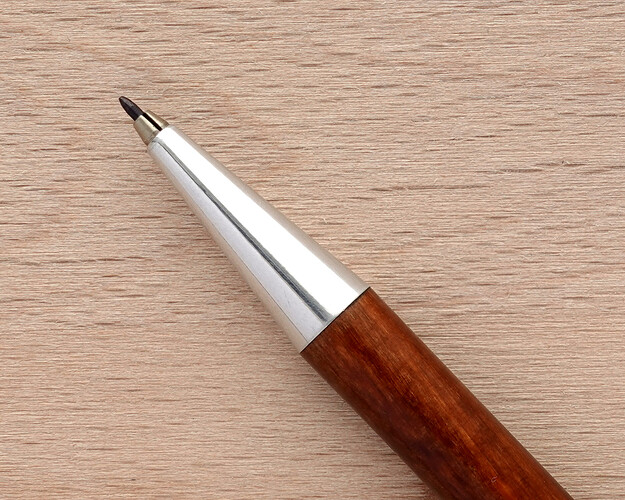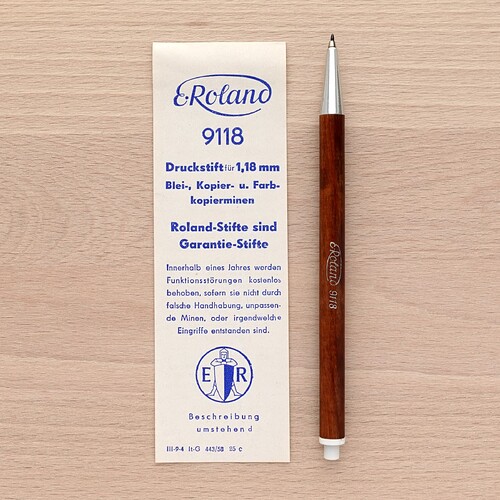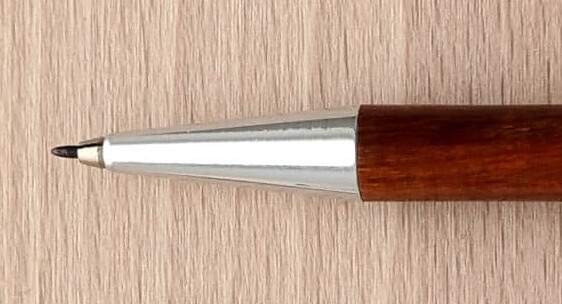Continuing from here: Another challenge.
This may be my lucky strike; I’d say it is a 1.18mm clutch pencil, but of the knock-advance type.
I hereby leave my guess: an E.Roland (possibly a Fallstop?) with round body.
There is a code number, but I don’t have the pencil with me right now; let me get back home, and find the piece…
Wow, that was quick! You’re right – it’s the E. Roland 9118, made in the GDR in the late 1950s.
Yes, it has a knock-advance. And I thought it was difficult … ![]()
that is a pretty pencil
Gorgeous! Do you know what kind of wood was used?
Also is that rear cap/knob on the back made of anodized metal or plastic?
Unfortunately I can’t identify the type of wood. However, it smells a little of phenolic resin, i. e. like the printed circuit boards made from pertinax (yes, it’s a bit annoying). I assume that the wood has been treated with phenolic resin to make it more durable. – The knob is made from plastic.
Very interesting. The matte looking finish has a nice grain to it. So you believe it to be a type of wood with a resin coating? I wonder… given the age, if it might be bakelite, also a phenolic resin that was very popular in the 1950’s.
That nose cone is almost unmistakable. ![]()
Now let me see what I can try to find, in order to play this game at the level of the masters I’ve seen so far fighting in the arena.
Opening the new thread by tomorrow: I have to check for some pictures…
I’d never heard of “Roland” before. And actually, the only name association I have for it is for early music synthesizers that came out in the 1980’s.
And yes, that nose cone is quite distinctive! Looks like those clutch teeth (prongs?) are made of brass.
Yes, there is that Roland company making electric music instruments.
I actually know of only two main models from “E. Roland” the pencilmaking firm, but there could be more. Both model sport the wooden outer shell. One has a more standard hexagonal body, see e.g. here for an example on Ebay, whereas the one framed by Gunther is the round version (possibly for stenographers?): models 818/20 in 2.00 mm, and 9118 in 1.18mm, respectively.
The silver foil imprint is prone to fading away, and finding a pristine specimen with paper like the one showed above is not that easy. In the US market, I’ve only seen such pencils with a reasonable frequency in Dan Linn’s shop, whereas in Europe they are probably a bit more common.
Right on the tip of my tongue edge of my collective memories. I swear!!
It’s definitely wood, not bakelite. – In the GDR phenolic resin was very popular. It was even used for the body of their Trabant car (52%; 46% were cotton filbers).
Yes, it looks like it but I’m not sure.
I’m not sure what came after E. Roland but as far as I know the company became a PGH (Produktionsgenossenschaft des Handwerks, a socialist co-operative) and continued to make writing implements, including the EMPOR 18-20 leadholder (for 1.8 and 2.0 mm leads, as the name suggests). I have one and will show it one day, but the build quality is not as good as the Roland.
The sheer quantity of pencil-specific knowledge on this forum boggles the mind!
It will be a rare and wonderful writing instrument indeed that defeats the Name that PENCIL or PEN crew.



